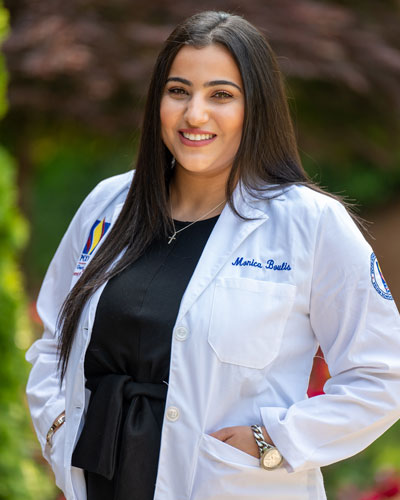How to Become a Pharmacist
October 28, 2025Do you want to help patients get the most out of their medications? Are you looking
for a rewarding career with the flexibility to work in a variety of healthcare settings?
Pharmacists make an immediate impact on the health and wellness of their community
and enjoy an abundance of career paths. Follow these steps to become a pharmacist:
Step 1: Complete prerequisite coursework
To become a pharmacist, you need to earn a Doctor of Pharmacy (PharmD) degree. But before applying to pharmacy schools, review the required prerequisite coursework. Most pharmacy schools will accept applications from students who have not earned
an undergraduate degree, but applicants must complete the prerequisite coursework
with satisfactory grades at an accredited college or university.
While prerequisite coursework varies widely between PharmD programs, you can expect
a fair amount of biology, chemistry and mathematics courses to be included.
Step 2: Choose a PharmD program
 Finding the right PharmD program for you will depend on many factors including cost,
location and curriculum. First and foremost, you will want to find out if the program
is accredited. You will not be able to practice pharmacy in the United States without
a Doctor of Pharmacy degree from a program accredited by the Accreditation Council
for Pharmacy Education (ACPE). PCOM School of Pharmacy's PharmD program is accredited by the ACPE through June 30, 2028.
Finding the right PharmD program for you will depend on many factors including cost,
location and curriculum. First and foremost, you will want to find out if the program
is accredited. You will not be able to practice pharmacy in the United States without
a Doctor of Pharmacy degree from a program accredited by the Accreditation Council
for Pharmacy Education (ACPE). PCOM School of Pharmacy's PharmD program is accredited by the ACPE through June 30, 2028.
Campus tours and visits are good ways to learn about a program. Prospective students can tour classrooms
and labs, interact with current students and meet faculty and staff. It's an opportunity
to ask questions and find out what sets programs apart.
“What I love about our school is the classroom sizes are relatively small compared
to other schools or institutions. And so as a result, I get to know our students on
a level that I may not get to if our classroom sizes were larger.”
- Shari Allen, PharmD, BCPP; clinical pharmacist and associate professor
PCOM School of Pharmacy is located at our PCOM Georgia campus in Suwanee (metro Atlanta area). The state-of-the-art teaching laboratories provide the perfect environment for practical training. PharmD students at PCOM Georgia
also receive ample interprofessional training in collaboration with the medical, nurse practitioner and physical therapy students
on campus. Experience PCOM Georgia by attending one of our virtual or in-person events.
Step 3: Apply to PharmD school
The majority of pharmacy schools in the United States participate in the centralized
Pharmacy College Application Service (PharmCAS). PharmCAS allows prospective students to apply to multiple PharmD degree programs
at once. Applicants must complete all PharmCAS application requirements as well as
requirements set by individual schools. Some application requirements to be aware
of are satisfactory prerequisite coursework GPAs, letters of recommendation and an
interview process.
Application Requirements - PCOM School of Pharmacy
While not required by all pharmacy schools, prospective students can also submit their
Pharmacy College Admission Test (PCAT) score. This standardized exam helps schools
determine if an applicant is qualified for their program. A good PCAT score can be
especially helpful to students with lower GPAs.
PCOM School of Pharmacy Early Assurance Program
Eligible high schoolers and undergraduate students can be accepted into the PCOM School
of Pharmacy by participating in the Early Assurance Pharmacy Program. As long as participants of the Early Assurance Pharmacy Program continue to meet
all applicant criteria and maintain specified academic requirements, a spot will be
reserved for them in the PharmD program.
Step 4: Complete PharmD degree program
Pharmacy school offers students the foundational knowledge and skills to practice
pharmacy in a variety of healthcare settings and perform as medication experts.
PCOM School of Pharmacy achieves its mission through advancement of contemporary pharmacy
practice. The school trains students to become collaborative members of healthcare
teams and is dedicated to promoting the health and well-being of diverse communities.
Students will learn patient-centered care with a focus on interprofessional education,
commitment to service, and lifelong personal and professional development.
“Our integrated science and therapeutics courses provide a strong foundational basis
for pharmacy practice in community, outpatient, institutional and general medicine
settings.”
- Michael J. Lee, PhD; Assistant Dean for Professional and Student Affairs
How long does it take to become a pharmacist?
Pre-pharmacy study can take 2-4 academic years to complete. It generally takes four
academic years to complete a PharmD program. The first three professional years of
the PharmD curriculum at PCOM Georgia include classroom lectures, lab work and Introductory Pharmacy Practice Experiences (IPPEs). IPPEs offer students experiential training in community and hospital pharmacies.
Students receive more responsibility for patient care as they progress through the
program which results in more confident and independent pharmacy practitioners. PharmD
students also have the opportunity to choose a specialty concentration in their third professional year of the program. Concentrations include medical cannabis and nuclear pharmacy.
The fourth professional year of the PCOM PharmD program curriculum includes Advanced
Pharmacy Practice Experiences (APPEs) rotations which allow students to gain clinical
experience in multiple areas, often at major health systems. Students can choose from
a variety of elective rotations that fit their interests and/or specialty concentration.
Step 5: Pass licensure exam and obtain state license
Doctor of Pharmacy graduates must pass the North American Pharmacist Licensure Examination (NAPLEX) before they are allowed to practice in the U.S. There are also additional licensure
requirements specified by each state board of pharmacy. For more information, consult
the board of pharmacy in the state where you plan to practice.
Step 6: Begin your career as a pharmacist
Pharmacists are found in a variety of healthcare settings including community pharmacies,
private medical offices, hospitals and long-term care facilities. They work for labs,
regulatory agencies, universities and pharmaceutical companies. Learn more about career options for pharmacists.
The job outlook for pharmacists is strong. According to the U.S. Bureau of Labor Statistics
(BLS), more than 14,200 job openings are projected each year from 2024 to 2034. Coupled with median salaries in the six figures, now is an excellent time to begin your pharmacy journey.
You May Also Like
Disclaimer: The video featured in this article was produced using an AI-powered tool to transform
text into visual content, including AI-generated voiceovers. The audio was produced
using AI narration.
Article last updated: 10/29/25
Originally published: 10/13/22

 Finding the right PharmD program for you will depend on many factors including cost,
location and curriculum. First and foremost, you will want to find out if the program
is accredited. You will not be able to practice pharmacy in the United States without
a Doctor of Pharmacy degree from a program accredited by the Accreditation Council
for Pharmacy Education (ACPE).
Finding the right PharmD program for you will depend on many factors including cost,
location and curriculum. First and foremost, you will want to find out if the program
is accredited. You will not be able to practice pharmacy in the United States without
a Doctor of Pharmacy degree from a program accredited by the Accreditation Council
for Pharmacy Education (ACPE). 